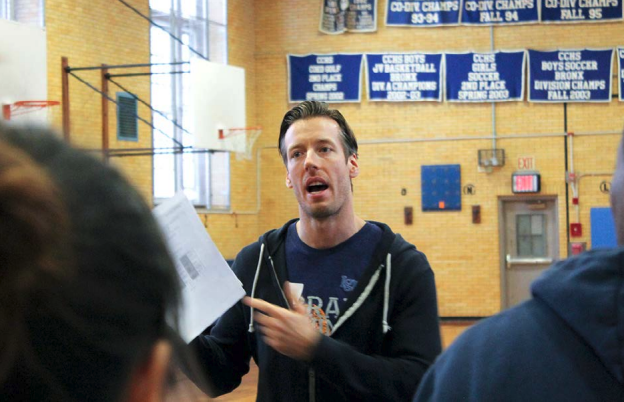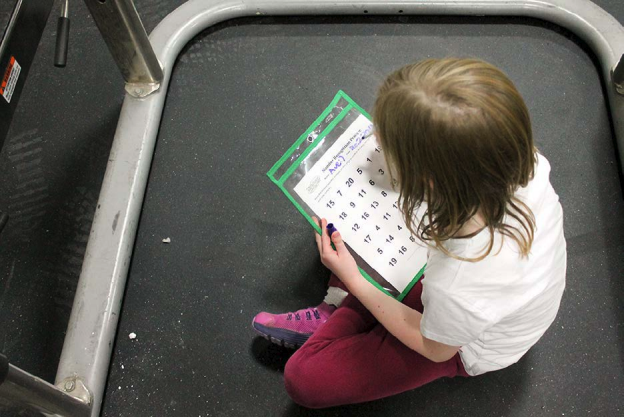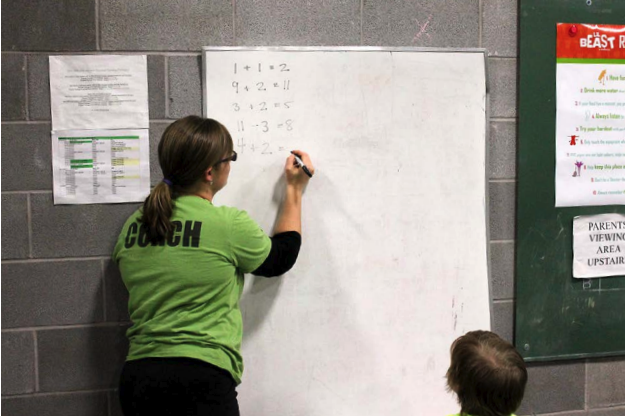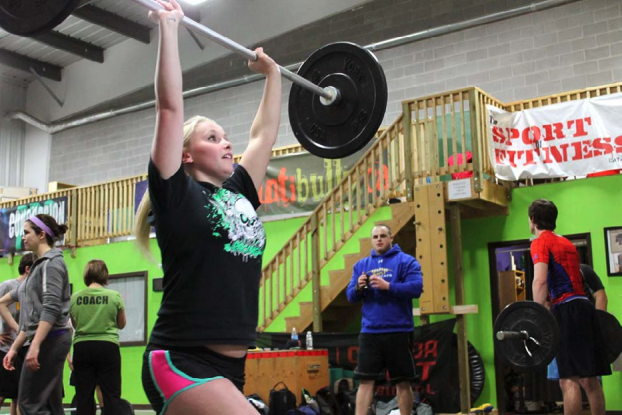Physical education has flatlined.
While the obesity epidemic rages and many schools lack the money, time or knowledge to implement a comprehensive approach to physical activity, CrossFit Kids is bringing fitness back into the curriculum, and the growing demand is creating new opportunities for CrossFit Kids affiliates.
Though a school may not be able to pay for coaches to run programs, money is often available through not-for-profit agencies, various foundations and government programs. And if you know where to look, it’s easy to find.
“Finding grants where schools are eligible is fairly easy,” said Lura Poggi, Coordinator of School Programs for CrossFit Kids.
Some CrossFit affiliate owners are now leveraging these grants to pay more coaches, expand their businesses, help more kids and revive P.E. in their communities.

Traditional physical education can get a shot in the arm from creative teachers who know how to access special funding.
CrossFit Hurricane Blows the Doors Off
Louisiana is the 48th healthiest state in the United States according to America’s Health Rankings, and one in three Louisiana kids is obese. John Wilson, owner of Hurricane CrossFit, is attempting to solve the puzzle. His affiliate is located in Lake Charles, La., between New Orleans and Houston, Texas.
When Wilson learned of a US$300,000 grant fund from Blue Cross Blue Shield to help kids in Louisiana get fit, he immediately realized he had a perfect partner within his gym: Dr. Sabrah Kingham is the principal of St. John Elementary school in Lake Charles, and she’s also a CrossFit athlete.
The Dare to Be Healthy grant is available to schools implementing fitness and nutrition programs in Louisiana and may be available in other states under another name.
“When the grantwriter for our district said that she didn’t know how to use the funds, I said, ‘I do!’” Kingham said.
Kingham had already begun an after-school exercise program for students, and more than a hundred kids had signed up. Kingham’s proposal to Blue Cross Blue Shield was to have more teachers trained as CrossFit Level 1 coaches and CrossFit Kids coaches so she could expand the program and study the results of exercise on kids. Kingham was awarded $30,000, enough to train 15 coaches.
St. John’s Elementary will become a CrossFit Kids affiliate before starting the program. Affiliation is free for schools after teachers have attended a CrossFit Kids course. They also receive a 20 percent discount on the CrossFit Level 1 Trainer Course and the CrossFit Kids course.
“Early intervention is key for anything: nutrition, physical fitness, social skills; it all goes together,” Kingham said. “You have to educate them on making good choices and staying physically fit. Seeing the benefit of exercise on their academic performance, how they feel, their self-image, their social skills, and the self-confidence to stand up to bullies makes it full circle.”
Wilson will lead the program, and teachers who have completed the CrossFit Kids seminar will act as assistants. Students are eager to start the program, and Kingham has opened two more days of workouts each week to accommodate the demand. The program will grow as more teachers earn CrossFit Kids certificates.
Teachers earning CrossFit Level 1 and CrossFit Kids certificates through the funded program will volunteer as tutors in Wilson’s gym, taking the program beyond the physical. Hurricane CrossFit has built a separate room for one-on-one tutoring.
“The kids are saying, ‘When can we sign up?’ They can choose other clubs for P.E. credit, but they choose CrossFit over soccer, football or basketball. They even sign a little contract agreeing to be there, and their parents sign it, too,” Kingham said. “This year, we’ll have a little educational seminar for parents where we can show data and then talk with them about nutrition. John (Wilson) will be there, too. We want to make sure there’s that connection between home and school and that it’s sustained.”

Most schools separate learning and fitness, but CrossFit Kids can bring them together with impressive results.
The Opportunity for Schools
What’s more important: teaching the rules of games or instilling a lifetime love of the pursuit of fitness? To a CrossFit athlete the answer is obvious. So why do schools teach dodgeball, handball and basketball in P.E.?
The CrossFit Kids curriculum solves many of the problems schools face: it provides a method, a progression and an attractive alternative to dodgeball. It’s been integrated into a host of schools already, so institutions looking to make a switch have access to lots of answers to the questions of what, when and how. Because many workouts can even be done in a classroom, the last question for most schools is, “Who can deliver this program?”
“In most cases, schools get the grants and hire the CrossFit Kids box to deliver,” said Poggi. “Most grantors aren’t going to give money to anyone who’s for-profit. So most grantors will look for nonprofits or schools.”
According to Poggi, the funding process usually starts with a parent relationship—a member of the gym who serves as part of a parent-teacher association or teaches at the school, for instance. But even when gyms don’t have a strong connection to their local school district, they can still forge one using external funds.
“The grant application is written by whatever individual will sit down and do it—sometimes a box member, sometimes a teacher or an administrator,” Poggi said. “People think, ‘I can’t just do it,’ but it’s very simple. Just be very clear about what you’re going to do in your program, how you’re going to spend your money. It doesn’t have to be complicated.”
The reporting process after a grant has been awarded can be just as daunting, but when the school is listed as the recipient, it will oversee how funds are used. According to Poggi, this is the most time-consuming part of the process.
“(Reporting is) often harder than getting the money. Overseeing the funds and reporting are sometimes the most cumbersome part. But it’s up to the school to oversee it anyway,” she said.
Finding a Fulcrum: Get Creative
On Sept. 30, 2013, the U.S. Department of Education awarded 60 grants worth a total of almost $32 million to education agencies and public and private community-based organizations to deliver nutrition and physical-education programs.
Money is definitely available for those who seek it, both from public and not-for-profit sources.* Though some funding is available for research, other grants simply require that an “ongoing” program be launched with the funds. Such a program could include for-profit initiatives like CrossFit Kids.
CrossFit Kids gyms searching for third-party funding sources shouldn’t limit themselves to grants only applying to physical fitness. As a large volume of research emerges supporting the benefits of exercise on learning, supplementary physical-education programs are becoming more appealing to funding sources—and parents.
Social programs, like those for kids with special needs, may have funding available for extracurricular activities. In the extreme, some insurance plans covering juvenile brain injury have funded daily in-gym programs combining schoolwork with squats.
After cancer treatment, children are sometimes diagnosed with “chemo brain,” a loss of working memory capacity. Symptoms can be moderated through exercise, and some funding sources for treatment of juvenile cancer are beginning to recognize the potential benefits of exercise on long-term recovery.
In other cases, school districts have formed classes for groups of at-risk kids. Rather than confining the “problem students” into a classroom, using CrossFit as an intervention can be an appealing choice.
CrossFit Canton approached middle schools in Georgia about an after-school enrichment program. They used their best advocates: the members at their gym.
“Our members who either teach at the schools or have kids who attend the schools approached the school and pretty much sold it for me,” said Karen Camp of CrossFit Canton. “I just called, followed up and set it up.”
The school made parents aware of the program, and interested parents enrolled their kids through CrossFit Canton. Camp’s program included CrossFit Kids workouts and homework help.
Integrating a subject like math into a CrossFit Kids workout can be as simple as requiring multiplication exercises between squats or building addition and subtraction into a shuttle run. Other gyms incorporate public speaking into workouts: CrossFit Brand X in Ramona, Calif., routinely has its teenage athletes present movements to peer groups to practice speaking in front of an audience.

Adding a math program to a CrossFit Kids workout can expand a gym’s offering and create new funding possibilities.
Parents who pay for after-school tutoring may also be attracted to programs combining CrossFit Kids with subject-specific help. In many cities, pricing for small-group tutoring is comparable to pricing for small-group personal training; mixing “homework time” into a hockey player’s workout is simple. Best of all, students look forward to their “brain workout.”
Camp has also run successful programs at CrossFit Canton for kids with special needs, such as those diagnosed with autism and Down syndrome. Other gyms have had success with similar programs.
A growing body of research supports using exercise to moderate behavior, decrease negative symptoms and improve cognition in children. Long-term risk for cognitive decline is also considerably lessened when kids exercise more.
“There were 1,600 papers last year (2012) looking at exercise’s effect on cognition. All were positive in the direction of preventing cognitive decline and Alzheimer’s disease. That’s pretty conclusive proof,” said Dr. John Ratey, Harvard researcher and author of Spark: The Revolutionary New Science of Exercise and the Brain.
When a child enjoys play and a parent can see potential benefits beyond physical health, a well-designed CrossFit Kids program has very broad appeal.
There are other creative ways to bring CrossFit Kids into a curriculum. Social programs, like anti-bullying and leadership initiatives, may have unused funds, and tailoring a CrossFit Kids program to match can be simple.
“I was just talking with a teacher who was thinking that her school should be using CrossFit as a means to help these kids. Her school had just done an in-service on bullying, and they just watched a movie about it,” Poggi said. “It’s definitely bubbling to the surface now. We have a lot of box owners who are talking about summer camps, and some boxes are automatically going to morph their program that way.”
If it initially seems odd to connect CrossFit Kids with an anti-bullying initiative, consider that some charter schools using CrossFit Kids build a “leadership” component directly into their physical-education classes. It’s not a stretch: many CrossFit Kids coaches can testify to the character-building benefits of the program, which emphasizes effort, accountability and the pursuit of excellence. The trick is to identify those benefits, build a curriculum around them and then find a suitable grant opportunity.
Some schools look for measurable outcomes. Especially with older students, the inclusion of a credential—such as a certificate or a diploma—may build the appeal of an externally run physical-education program. For example, a 10-week physical-leadership course that combines CrossFit workouts, public speaking and peer coaching might be more attractive to a school principal if her students can earn a certificate for completion at the end.
Finally, several CrossFit Kids gyms are now adding a tutoring service or work on a specific academic subject to their classes. At Kitsap CrossFit, Brandi Exarhos launched a CrossFit Kids Spanish program in September.
“The kids are eager to learn and look forward to sitting down for Spanish after they have worked up a sweat,” Exarhos said. “I really wanted to use this session as a test to see how back-to-back classes would work logistically for the kids, parents and the gym. It’s been smooth sailing for the most part, and I look forward to being able to offer other options (math, reading, etc.) next time around.”
With so many options available to affiliates and schools, Poggi offered to look over grant proposals before they’re submitted.
“I can review grant proposals, proofread them and give feedback,” she said. Poggi can be reached at lura@crossfitkids.com, and the Educator Support section of the CrossFit Kids website has lots of information for teachers and administrators.
Rules of the Game

The measurable aspect of CrossFit makes it ideal for administrators who are under pressure to get results that justify funding.
The potential upside for CrossFit affiliates is huge: an opportunity to provide meaningful employment for a full-time CrossFit Kids coach, more kids in classes and more parents exposed to CrossFit.
“Educators see this snowball and say, ‘I’ve got to look into that,’” said Poggi. “We have a database of over 1,500 teachers who have contacted us around using CrossFit Kids as their phys.-ed. curriculum or in their school.”
And these schools need CrossFit Kids coaches.
“Because of the fiscal realities of education, the two communities are going to rely heavily on one another,” Poggi continued.
Restrictions on CrossFit Kids affiliates are minimal.
Many schools want the benefits of the CrossFit Kids program without asking their teachers to take the course. In these cases, CrossFit Kids coaches may attend and teach all the classes they like. A CrossFit Kids coach can visit schools and deliver after-school programs without the school itself becoming an affiliate or obtaining its own CrossFit Kids coaches.
“I can go lead programs at any school in the district or help phys.-ed. teachers in the district without a problem,” Poggi said.
A CrossFit Kids coach must work only within one school district.
“As a CrossFit Kids trainer, I can go and do an after-school program at all the different schools within a district,” Poggi explained. “But if the school wants to become a formal CrossFit Kids affiliate program, they can only be attached to one trainer. Each school can only be affiliated with one trainer.”
Some schools want to be become CrossFit Kids affiliates or have their teachers attend the CrossFit Kids Seminar. In that case, each school must become its own affiliate; a district cannot affiliate. As stated earlier, affiliation is free after at least one teacher on staff has taken the CrossFit Kids course.
The Body—and Beyond
Though not a teacher himself, Wilson leveraged his connections to bring cognitive enhancement and CrossFit to hundreds of children in his city.
“Our goal moving forward is to have 10 local schools be CrossFit Kids affiliates, including a charter school. Two will be coming online as soon as they (obtain their certificates). I have five other P.E. coaches who are coming in and working out. It’s just a matter of time,” Wilson said.
He’s not coasting, either.
“We want to see if we can build a 12-by-12 classroom at our gym, and we’re looking for volunteer tutors. Maybe it could be some of the give-back for teachers who are having their (seminars) paid for. We’ll be utilizing the Khan Academy for help,” Wilson said, referencing the non-profit educational website whose mission is to provide “a free world-class education for anyone anywhere.”
Wilson is one of several affiliate owners who are blazing a trail into the educational realm. By leveraging the social, emotional and physical benefits of CrossFit Kids, other boxes can follow his lead.
“If kids can have access (to CrossFit) through the schools, then that’s a huge gift that we’re giving to this generation,” Poggi said.
*Grant Sources
Wilson used a grant from Blue Cross Blue Shield of Louisiana, and the funder has similar programs in several states. In Illinois, the program is called Healthy Kids, Healthy Families and may have other names in other states.
Some programs, such as GoodSports, will fund the purchase of equipment for physical-education programs. Others, such as SparkPE, serve as a clearing house for hundreds of grants promoting health, nutrition and fitness.
CrossFit Kids regularly posts additional grant opportunities on its Facebook page. Affiliates and schools are encouraged to research the grants available and put together creative programs that qualify
Found Money